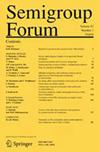保留等价性的限定范围变换半群上的自然偏序
IF 0.7
3区 数学
Q2 MATHEMATICS
引用次数: 0
摘要
让 Y 是 X 的一个非空子集,T(X, Y) 是所有从 X 到 Y 的函数的集合。那么,T(X, Y) 的组成是完整变换半群 T(X) 的一个子半群。定义 T(X, Y) 的子半群 \(T_E(X,Y)\) 为 $$\begin{aligned}.T_E(X,Y)={T(X,Y)中的(x,y):\forall (x,y)\in E, (x\alpha ,y\alpha )\in E\}.\end{aligned}$$我们用自然偏序来研究 \(T_E(X,Y)\),并确定两个元素在此序下何时相关。我们还给出了 \(T_E(X,Y)\)上相容性的特征,然后描述了最大元素和最小元素。本文章由计算机程序翻译,如有差异,请以英文原文为准。
The natural partial order on semigroups of transformations with restricted range that preserve an equivalence
Let Y be a nonempty subset of X and T(X, Y) the set of all functions from X into Y. Then T(X, Y) with composition is a subsemigroup of the full transformation semigroup T(X). Let E be a nontrivial equivalence on X. Define a subsemigroup \(T_E(X,Y)\) of T(X, Y) by
$$\begin{aligned} T_E(X,Y)=\{\alpha \in T(X,Y):\forall (x,y)\in E, (x\alpha ,y\alpha )\in E\}. \end{aligned}$$We study \(T_E(X,Y)\) with the natural partial order and determine when two elements are related under this order. We also give a characterization of compatibility on \(T_E(X,Y)\) and then describe the maximal and minimal elements.
求助全文
通过发布文献求助,成功后即可免费获取论文全文。
去求助
来源期刊

Semigroup Forum
数学-数学
CiteScore
1.50
自引率
14.30%
发文量
79
审稿时长
12 months
期刊介绍:
Semigroup Forum is a platform for speedy and efficient transmission of information on current research in semigroup theory.
Scope: Algebraic semigroups, topological semigroups, partially ordered semigroups, semigroups of measures and harmonic analysis on semigroups, numerical semigroups, transformation semigroups, semigroups of operators, and applications of semigroup theory to other disciplines such as ring theory, category theory, automata, logic, etc.
Languages: English (preferred), French, German, Russian.
Survey Articles: Expository, such as a symposium lecture. Of any length. May include original work, but should present the nonspecialist with a reasonably elementary and self-contained account of the fundamental parts of the subject.
Research Articles: Will be subject to the usual refereeing procedure.
Research Announcements: Description, limited to eight pages, of new results, mostly without proofs, of full length papers appearing elsewhere. The announcement must be accompanied by a copy of the unabridged version.
Short Notes: (Maximum 4 pages) Worthy of the readers'' attention, such as new proofs, significant generalizations of known facts, comments on unsolved problems, historical remarks, etc.
Research Problems: Unsolved research problems.
Announcements: Of conferences, seminars, and symposia on Semigroup Theory.
Abstracts and Bibliographical Items: Abstracts in English, limited to one page, of completed work are solicited.
Listings of books, papers, and lecture notes previously published elsewhere and, above all, of new papers for which preprints are available are solicited from all authors.
Abstracts for Reviewing Journals: Authors are invited to provide with their manuscript informally a one-page abstract of their contribution with key words and phrases and with subject matter classification. This material will be forwarded to Zentralblatt für Mathematik.
 求助内容:
求助内容: 应助结果提醒方式:
应助结果提醒方式:


